Phonoharp and the Columbia Zither
On Aug. 4, 1891, William W. Batchelder, Jr. of Boston secured patent number 456,977. He assigned one-half of his right to Joseph R. Green of Malden, MA. The patent described a bridge which shielded unwanted notes from a pick or finger drawn across all the strings of an instrument. You can see one version of this bridge in the first image, below. That patent date appears on a wide variety of instruments using that type of bridge, all the way from the one pictured, which has the form of a pleasantly-shaped box with a soundhole, down to a simple flat board with strings stretched across it. And it turns out to produce a pretty pleasing sound. If you hold the instrument with the long side toward you, you can pick melody notes with your right hand and stroke chords with your left. There tends to be a lot of metallic noise as you drag across the bridge, but if you play with the back of a fingernail, it's not too objectionable.
The bridge was susceptible to being smashed down into the strings, causing them to buzz or fail to sound at all. In 1894 Batchelder received an additional patent for height adjusting screws for the bridge. This time he assigned the patent to The Phonoharp Company, Berwick, Maine.
"The Phonoharp Company had been incorporated on April 27, 1892, in Maine, where it did business both in Berwick and Portland. Within a year the company had opened offices in Boston, moving into its factory at 150 Liverpool Street in 1897." (Becky Blackley, The Autoharp Book)
An advertisement in the "The Folio" magazine for July of 1894 declares "This is the Phonoharp." It shows an instrument identical to the one below. It also describes an instrument which produced 6 chords and could play in F and C. The address is given as 665 Washington Street, Boston. Another advertisement, in "Ladies' Home Journal" in 1895, lists the address as 630 Washington Street, Boston. It lists the same models of the Phonoharp, but it adds a listing of the Columbia Zither. This is the earliest form of the chord instrument which was produced in such great volume and wide variety by the Phonoharp Co. It's interesting to note how early this instrument was available following the issuance of the 1894 patent. Phonoharp apparently purchased a license to the patent (presumably from Menzenhauer), because its date appears on the note label of almost all of their instruments. Menzenhauer & Schmidt were manufacturing instruments under the same patent throughout the lifetime of the Phonoharp Co.
The Sears catalog for Fall 1896 shows a Columbia zither, apparently set up to play in F and C. It has 4 chords and there's a damper bar over them. Even this early, the instrument had its characteristic Phonoharp shape. The sizes and proportions varied much over the years, but the salient features were always there. First, there's a curved bout whose widest point is near the tuning pin for the highest string. Second, there's a little "peak" where the upper bridge changed direction. And third, there's shallow S-shaped contour along the upper bridge of the chord section, with an upper bridge that's angled to make the strings of the outside chord longer than the strings of the inside chord.
There's one other significant difference between the Phonoharp products and the Menzenhauer & Schmidt products. On the Phonoharp instruments, the heavy bass string of the chord is closest to the long side of the instrument. The rest of the chord is built toward the center. The #1 chord (usually C) is at the outside of the instrument, and the #4 is closest to the melody strings.
Menzenhauer & Schmidt instruments are reversed. The #1 chord is closest to the melody strings, the heavy string is toward the center, and the chords are built toward the long side.
For Fall 1897, Sears listed only Menzenhauer instruments - 4 different models. The name they applied to them was Guitar Zither.
Spring of 1898 showed the same guitar zithers, but the Regent zither appeared, in 2 models. My suspicion is that the Phonoharp Co. made these as well, because later instruments use some of the same decals. But there's some connection with the Flagg Mfg Co., as well. The music that's with an early Regent that I have states "Copyright 1897, Flagg Mfg Co." But Flagg made the Apollo Harp (patented in 1895 and heavily represented in Sears at this same time), which is quite a different instrument than the various chord instruments.
The Regent is a veritable chord machine. Its 43 strings are laid out in 5 chords, with no dedicated melody section. However, they carefully numbered the strings so that you could use number music to play them. Unfortunately, of course, the numbers are scattered throughout the various chords rather than being in order, so they were probably even less help than usual. The music, as usual, was placed under the strings and contained little maps for playing songs. Regent music is a bit different, though, because it includes lines which tell you how much of the chord you should play.
Here on the east coast, a man named A. J. Beauchamp, of Penn Yan, NY, seems to have been a major distributor. His name appears in the soundhole, sometimes pasted over what appears to be a Phonoharp label, and he printed an instruction sheet.
The Regent was gone from Sears by Fall 1899. I suspect, though, from the instruments I've seen, that production continued beyond that time. And a patent issued to George A. Fullerton in 1901, and assigned to the Phonoharp Co. of Portland, Maine, shows an improvement to the hitch pin block of what is clearly a Regent zither.
The Regent is a delightful instrument to hear. The chords have as many as 11 notes and some span 3 octaves.
Fall 1899 in Sears showed a complete lineup of 4 styles Phonoharp instruments. The use of decals for the soundhole and note label appeared for the first time, along with instruments that still had paper note labels and painted lines for decoration.
In April, 1901, Joseph R. Green received a patent (rights assigned to Phonoharp) for a sort of 5-sided instrument which had the chord strings running from one side to another, and the melody strings running between two other side, nearly perpendicular to (and passing under) the chord strings. Green recognized the playing limitations which resulted from placing a zither in its design position. He even mentioned that most proficient players turn the instrument 90 degrees (as described in How do you play it?) for improved melody playing, but felt that there was still a drawback for left hand playing. By placing the sections at the angles he chose, he allowed the strings to meet the hands at natural angles (much like ergonomic computer keyboards). And indeed, if you lay the patent picture in front of you with the proper side against you, the strings fall easily to hand.
But the execution didn't quite live up to the promise of the design. The Fall 1901 Sears catalog listed the wonderful Zitho-Harp, an instrument with separate levels of melody and chord strings. But the strings cross at exact right angles, not a natural angle. And if you place the side toward you that the layout of the decals seems to indicate, you're back to having the melody strings running away from you. The only angle which provides access anywhere near Green's concept causes the longest pointiest part of the instrument to poke you in the stomach.
Unfortunately, having strings in 2 directions means that the instrument can collapse in 2 directions, which mine is doing despite the best intentions of a repairer before me. It is quite intriguing to look at, though. The label in the soundhole says "Bredsnall & Faber / Manufacturers / Zitho-Harp / Style "E" / Chicago, USA / 751 Milwaukee Ave." There are no decals, contours, or end cover shapes that resemble any Phonoharp instruments, so I'm guessing that this is not a Phonoharp product. Surely, though, Bredsnall & Faber had to license the Green patent.
By Spring 1905, the Zitho-Harp was still in the Sears catalog. Oscar Schmidt was now the main supplier of guitar-zithers. However, in a catalog with a different company name, but looking like Sears, there were still 5 models of Columbia zithers listed.
By 1908, no Columbia zithers appeared at all, but the Marx Pianoharp was there.
Some names of distributors of Phonoharp instruments - H. S. Nace, Philadelphia; Ed. Sutch, Philadelphia, J. Abrams, Home Educational Co., Concord, NC.
"… in 1926… the International Music Corporation was formed on April 26th by Alfred F. McCabe, William Banker, and John R. Turner. One day later the shares in the corporation were transferred to Oscar Schmidt, his son, Walter Schmidt, William A. Copeland, and Harold G. Finney. … Copeland and Finney were officers in the Phonoharp Company. This was not a merger of the two corporations, however, but the formation of an entirely new corporation. Although both Oscar Schmidt, Inc. and the Phonoharp Company continued to exist in their own right, The Phonoharp Company did little or no business on its own after the creation of International Music Corporation. The Phonoharp Company was finally dissolved by the Supreme Judicial Court of the State of Maine on November 5, 1928, by the petition of Harold G. Finney." (Becky Blackley, The Autoharp Book)
More to come, about Marx, and Celestaphones, and Marxophones... for now, here's a gallery of some Phonoharp instruments.
|
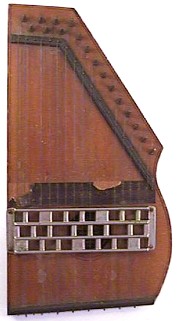
No.1 |
|
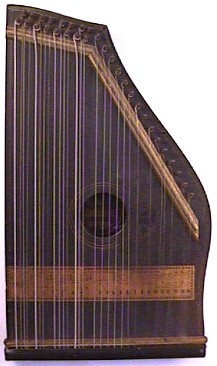
No.2, early
Note simple lines around soundhole, first style note label. |
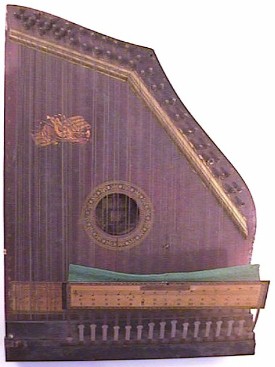
"Mandolin Harp"
With the familiar Phonoharp soundboard decal and soundhole decal like No.2 below |
|
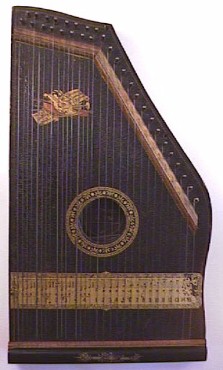
No. 2
My old standby practice instrument |
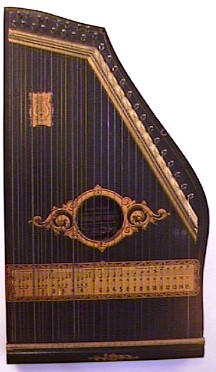
No.2, "Nace Bavarian Harp"
The best sound of any Phonoharp instrument I've heard, and the coolest soundhole decal! |
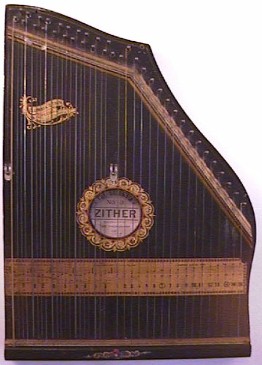
No. 3
Missing the damper bar across the chord strings |

No. 3 3/4 |
Drop me a line.
Go back to the Guitar-Zither Clearinghouse, or home.
These pages were banged out with Word 97.